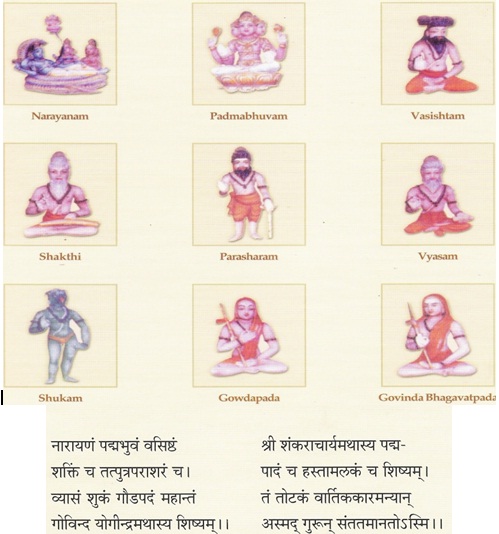
Preceptors of Advaita
Vasishta
by
K.S Ramaswami Sastri
B.A., B.L.
Vasishtha is one of the supreme seers, sages and saints of India. In the course of uttering the Gayatri-mantra day after day, the names of seven sages (Atri, Bhrigu, Kutsa, Vasishtha, Goutama, Kasyapa and Angirasa) are repeated every day. In Valmiki’s world-famous epic poem Ramayana (the 19th sarga or chapter in the Bala-kanda) the sage Visvamitra goes to King Dasaratha of Ayodhya to ask him to send Rama with him to protect from destruction by demons the sacrifice that was going to be performed by him. King Dasaratha was unwilling to do so because Rama was young.
Thereupon Visvamitra tells him:
Aham vedmi mahatmanam
Ramam satya-pararakramam
Vasishtho’pi mahatejah
Ye chanye tapasi sthitah
(I know Rama to be high-souled and of true prowess. The sage of spiritual radiance --- Vasishtha --- and others who excel in tapas, i.e., spiritual austerity, also know him to be so.)
Even then the king was unwilling to send Rama with Visvamitra. But Vasishtha advised the king to grant Visvamitra’s request, and thereupon King Dasaratha sent Rama and Lakshmana with Visvamitra. Vasishtha was purohita (spiritual adviser) of the king of suryavamsa, i.e. the solar dynasty. Visvamitra taught them two potent mantras --- Bala and Atibala --- which enabled them to conquer hunger and thirst and perform miraculous acts. Visvamitra performed his projected sacrifice unhindered as Rama and Lakshmana protected it from all attackers.
After Rama and Lakshmana returned from the island of Lanka after destroying Ravana and his rule over the universe, Vasishtha was one of the eight sages who crowned Rama as the king of Ayodhya.
Vasistho vamadevascha jabaliratha kasyapah
Katyayano suyajnasca gautamo vijayas tatha
Abhyashinchan nara-vyaghram prasannena sugandhina
Salilena sahasraksham vasavo vasavam yatha
(Valmiki Ramayana --- Yuddha kanda, sarga 131 [Verses 61,62] )
(Vasishtha, Vamadeva, Jabali, Kasyapa, Katyayana, Suyajna Goutama and Vijaya performed the coronation of Rama with limpid and fragrant water, as vasus crowned Indra as the King of all the worlds.)
Such a consummating coronation of Sri Rama by Vasishtha was supplemented and perfected by another coronation. i.e. the gift of spiritual knowledge to Rama as described in the great work Yoga-Vasishtha which is as great in merit in its way as Valmiki Ramayana and is much bigger in size than Valmiki Ramayana. Adapting a well-known Sanskrit verse about Valmiki Ramayana we may say about Vasishtha’s work:
Vasishtha giri sambhuta
Rama sagara gamini
Punatu bhuvanam punya
Ramayana Mahanadi.
The first part of the work deals with vairagya (freedom from desire), Mumukshutva (desire for spiritual liberation), utpatti (creation), sthiti (preservation) and upasama (dissolution). The second part of the work consists of two sections, viz. Purvardha and Uttharardha (the first part and second part) which deal in great detail with nirvana (annihilation of individuality and achievement and spiritual experience of universality and divinity).
I shall quote in conclusion from Yoga-Vasishtha a few verses which combine wonderful beauty and divine sublimity.
Evam sarvamidam visvam paramatmaiva kevalam
Brahmaiva parakasam esa devah parah smritah
Tadetad pujanam sreyah tasmat sarvam avapyate
Tadaiva sargabhuh sarvam idam tasminnavasthitam
Akrtrimam anadyantam advitiyam akhanditam
Abahissadhanasadhyam sukham tasmad avapyate
(The whole universe is one with Paramatma, i.e. the Universal Lord. Brahman is known as Parakasa, i.e. the Supreme Sky. Worshipping Him is beneficial. From Him comes everything. He is the Creator of everything. All things rest to Him. He is the Creation. He is without beginning and end. He has no peer. He is undivided and indivisible and full. He is not created by an agency outside Him. We get all bliss from Him.)
This article highlights the contribution made by the preceptor Vasishta to the richness of Advaita philosophy. The philosophy of Advaita has been expounded by many preceptors from time immemorial. According to tradition, Isvara or God Himself as Narayana or Sadasiva revealed the Advaitic wisdom to his lotus-born son Brahma, the creator, who in turn imparted it to Vasistha. He in turn passed it to his son Sakti. He again taught his son Parasara who revealed it to his son Vyasa. Vyasa instructed it to his son Suka. Thus this wisdom was handed down at first as Vamsaparampara from father to son, in succession. The Sisyaparampara begins with Gaudapada, which is a line of succession from preceptor to disciple. It is also called Manava sampradaya as Gaudapada who systematised Advaita philosophy, happens to be a human preceptor. He is known to have meditated on Nara-Narayana and received the Advaita wisdom from the Lord. His disciple was Govinda Yogindra, who accepted Sankara as his disciple.
This article is from a publication brought out to commemorate the Diamond Jubilee of the ascension of Sri Chandrasekharendra Sarasvati Swamigal to the Kanchi Kamakoti pitha.